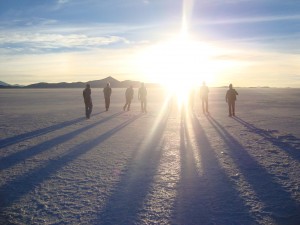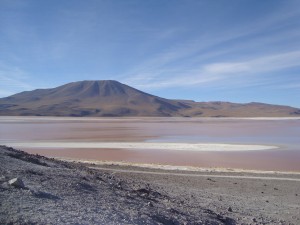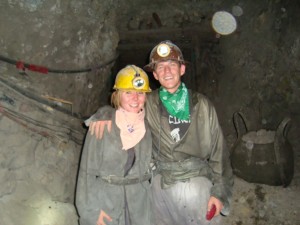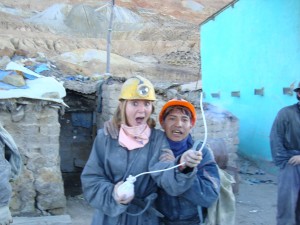After a 6 hour bus ride over completely unpaved roads we arrived at Uyuni. It is the most unattractive town we’d ever seen, so we wasted no time in booking a 3-day tour around the Salar de Uyuni and the remote Bolivian south-west.
The Salar de Uyuni (salt plains) are the dried up vestiges of a prehistoric salt lake which was left by the retreating ocean hundreds of thousands of years ago. They are utterly incredible: a vast, flat ethereal expanse which stretches boundlessly into the distance, like an immense ice sheet, playing optical illusions on the faraway mountains. Blindingly white, incomprehensibly large, and unbelievably beautiful.
We started off by visiting an island which was once a coral reef but now plays home to hundreds of phallic cacti sprouting skywards, some of which are 1200 years old. The view of the salt plains from the top of this reef was phenomenal. As is apparently obligatory, we messed around taking comical-perspective photos on the plains for a couple of hours before watching the sun set, the moon rise and the sky turn all sorts of colours over the empty lunar salt plains. Truly spectacular.
That night we stayed in a hotel made completely of salt, from the walls and tables to the chandeliers. We had to wrap up warm in our sleeping bags though to combat the -20 temperature!
Bright and early the next morning we were taken on a 4WD tour of what must be one of the most captivating landscapes on the planet. We bounced over rugged, almost martian, tundra, with mountains in every direction we cared to look, like huge piles of fine coloured sand: red, brown and yellow laced with white. A smouldering volcano belched smoke in the distance. We saw flocks of wild llama, vicunia (an almost extinct cousin of the llama), the odd mountain fox, and even a fleeting glimpse of a puma; we spied flamingoes swooping and landing on a blood-red lake; large semi-frozen lagoons and peculiar rock formations; a hissing geyser spouting sulphurous steam, mud bubbling under the heat of volcanic magma, and sparkling freshwater streams reflecting the bright blue in the cloudless sky. On the final day we bathed in a hot geothermal spring (the first opportunity we’d had to wash in three days!) before heading back to Uyuni. It was an absolutely unforgettable experience, one of the highlights of the trip and one that will be difficult to top.
Due to Uyuni being such an out-and-out dive (it really is!) we got straight on the night bus to La Paz where we will continue on to the Copa, Copacabana…!




